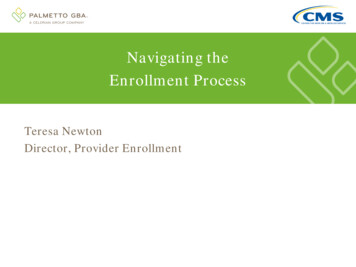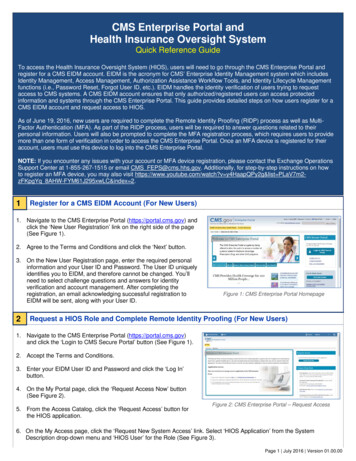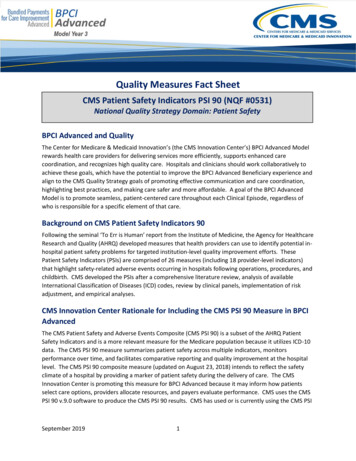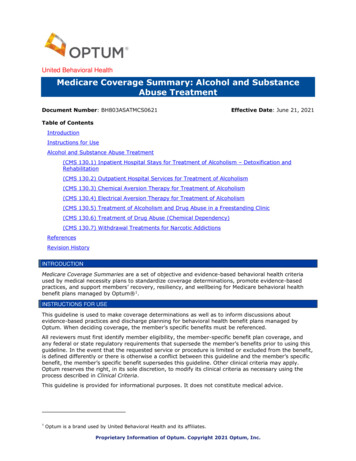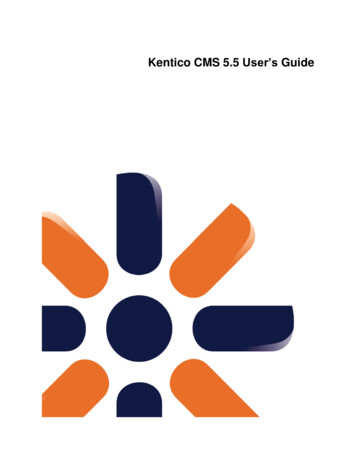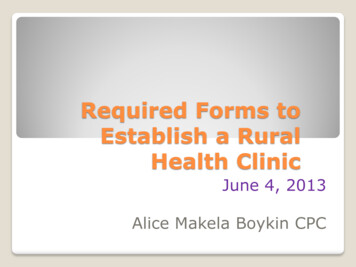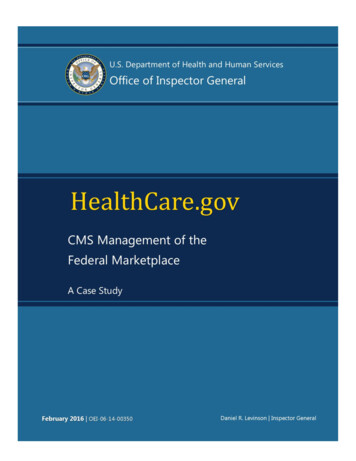
Transcription
OFFICE OF INSPECTOR GENERALhttp://oig.hhs.govThe mission of the Office of Inspector General (OIG), as mandated by Public Law 95-452, as amended, is to protectthe integrity of the Department of Health and Human Services (HHS) programs, as well as the health and welfare ofbeneficiaries served by those programs. This statutory mission is carried out through a nationwide network ofaudits, investigations, and inspections conducted by the following operating components:OFFICE OF AUDIT SERVICESThe Office of Audit Services (OAS) provides auditing services for HHS, either by conducting audits with its own auditresources or by overseeing audit work done by others. Audits examine the performance of HHS programs and/or itsgrantees and contractors in carrying out their respective responsibilities and are intended to provide independentassessments of HHS programs and operations. These assessments help reduce waste, abuse, and mismanagementand promote economy and efficiency throughout HHS.OFFICE OF EVALUATION AND INSPECTIONSThe Office of Evaluation and Inspections (OEI) conducts national evaluations to provide HHS, Congress, and thepublic with timely, useful, and reliable information on significant issues. These evaluations focus on preventingfraud, waste, or abuse and promoting economy, efficiency, and effectiveness of departmental programs. Topromote impact, OEI reports also present practical recommendations for improving program operations.OFFICE OF INVESTIGATIONSThe Office of Investigations (OI) conducts criminal, civil, and administrative investigations of fraud and misconductrelated to HHS programs, operations, and beneficiaries. With investigators working in all 50 States and the District ofColumbia, OI utilizes its resources by actively coordinating with the Department of Justice and other Federal, State,and local law enforcement authorities. The investigative efforts of OI often lead to criminal convictions,administrative sanctions, and/or civil monetary penalties.OFFICE OF COUNSEL TO THE INSPECTOR GENERALThe Office of Counsel to the Inspector General (OCIG) provides general legal services to OIG, rendering advice andopinions on HHS programs and operations and providing all legal support for OIG’s internal operations. OCIGrepresents OIG in all civil and administrative fraud and abuse cases involving HHS programs, including False ClaimsAct, program exclusion, and civil monetary penalty cases. In connection with these cases, OCIG also negotiates andmonitors corporate integrity agreements. OCIG renders advisory opinions, issues compliance program guidance,publishes fraud alerts, and provides other guidance to the health care industry concerning the anti-kickback statuteand other OIG enforcement authorities.
EXECUTIVE SUMMARYHealthCare.gov: Case Study of CMS Management of the Federal MarketplaceOEI-06-14-00350FOREWORDThis case study examines implementation of HealthCare.gov and the Federal Marketplace by the Centers forMedicare & Medicaid Services (CMS), from passage of the Affordable Care Act (ACA) in 2010 through the second openenrollment period in 2015. As required by the ACA, HealthCare.gov is the Federal website that facilitates purchase ofprivate health insurance for consumers who reside in States that did not establish health insurance marketplaces. Atits launch on October 1, 2013, and for some time after, HealthCare.gov users were met with website outages andtechnical malfunctions. After corrective action by CMS and contractors following the launch, CMS ended the first openenrollment period with 5.4 million individuals having selected a plan through the Federal Marketplace.In our oversight role for the Department of Health and Human Services (HHS), the Office of Inspector General (OIG)has a significant body of ongoing and planned audits and evaluations regarding the Federal Marketplace and otherACA provisions of high interest and concern to HHS, Congress, and other stakeholders. These include reviews andsuggestions for improvements related to the accuracy of Federal financial assistance payments; verifications ofeligibility determinations for insurance, premium tax credits, and cost-sharing reductions; and CMS’s management ofmarketplace contracts and the security of personal information. OIG reports about the marketplaces are availableonline at www.oig.hhs.gov/reports-and-publications/aca/, and additional information about our planned and ongoingwork is available online in OIG Work Plan documents at kplan/index.asp.ABOUT THIS CASE STUDYThe objective of this case study was to gain insight into CMS implementation and management of the FederalMarketplace, focusing primarily on HealthCare.gov. Our review spans 5 years, providing a chronology of events andidentifying factors that contributed to the website’s breakdown at launch, its recovery following corrective action, andimplementation of the Federal Marketplace through the second openenrollment period. OIG calls on CMS to address identified problemsWHAT’S INSIDE THIS REPORTand employ lessons learned from management of this project to avoid› Detailed chronology of CMS’sfuture problems with program implementation and to furtherdevelopment and implementation ofstrengthen CMS. In conducting this review, we interviewed 86 currentthe Federal Marketplace andand former HHS and CMS officials, staff, and contractors involved withHealthCare.gov in four chapters:the development and management of the website. We also reviewedthousands of HHS and CMS documents, including management reports,› Preparation & Developmentinternal correspondence, and website development contracts.› Final Countdown to LaunchWHAT WE FOUNDThe development of HealthCare.gov faced a high risk of failure, giventhe technical complexity required, the fixed deadline, and a high degreeof uncertainty about mission, scope, and funding. Still, we found thatHHS and CMS made many missteps throughout development andimplementation that led to the poor launch. Most critical was theabsence of clear leadership, which caused delays in decisionmaking,lack of clarity in project tasks, and the inability of CMS to recognize themagnitude of problems as the project deteriorated. Additional HHS andCMS missteps included devoting too much time to developing policy,which left too little time for developing the website; making poortechnical decisions; and failing to properly manage its key websiteOEI-06-14-00350›Launch, Correction, & First OpenEnrollment›Turnaround & Second OpenEnrollment› Key Contributing Factors to thewebsite breakdown and recovery› Call for continued progress withLessons Learned for ongoing CMSmanagement of HealthCare.gov› Glossary of key termsHealthCare.gov: Case Study of CMS Management of the Federal Marketplacei
EXECUTIVE SUMMARYdevelopment contract. CMS’s organizational structure and culture also hampered progress, including poorcoordination between policy and technical work, resistance to communicating and heeding warnings of “bad news,”and reluctance to alter plans in the face of problems. CMS continued on a failing path to developing HealthCare.govdespite signs of trouble, making rushed corrections shortly before the launch that proved insufficient. Thesestructural, cultural, and tactical deficiencies were particularly problematic for HealthCare.gov given the significantchallenges of implementing a new program involving multiple stakeholders and a large technology build.Following the launch on October 1, 2013, CMS and contractors pivoted quickly to corrective action, reorganizing thework to focus on key priorities and to improve execution. This required significant and focused effort to measurewebsite performance, correct problems with website capacity and functions, and establish a new project structure.Key factors that contributed to recovery of the website included CMS adopting a “badgeless” culture for the project,wherein all CMS staff and contractors worked together as a team, and a practice of “ruthless prioritization” thataligned work efforts with the most important and achievable goals. CMS recovered the HealthCare.gov website forhigh consumer use within 2 months, and adopted more effective organizational practices, such as closer integration ofpolicy and technical functions, developing redundancies in anticipation of problems, and flexibility in learning from andmodifying processes.CALL FOR CONTINUED PROGRESSCMS continues to face challenges in implementing the Federal Marketplace, and in improving operations and servicesprovided through HealthCare.gov. As of February 1, 2016, CMS reported that over 9.6 million consumers had selecteda health plan through the Federal Marketplace or had their coverage automatically renewed. As CMS moves forward,challenges include completing the automated financial management system and continuing to address areas OIG hasidentified in past reports as problematic or needing improvement. The agency has focused on this project for yearsand now must keep attuned to these challenges as it shifts focus to other work.OIG calls on CMS to continue progress in applying lessons learned from HealthCare.gov to avoid future problems andto maintain improvement across the agency. These lessons comprise core management principles that address bothspecific project challenges and organizational structure, and could apply to other organizations. CMS concurred withOIG’s call for continued progress, stating that it will continue to employ the lessons below and that, since OIG’s review,it has implemented several initiatives to further improve its management.LESSONS LEARNED LeadershipAssign clear project leadership to provide cohesion acrosstasks and a comprehensive view of progress. Promote acceptance of bad news and encourage staff toidentify and communicate problems. AlignmentAlign project and organizational strategies with theresources and expertise available. Identify and address factors of organizational culture thatmay affect project success. Seek to simplify processes, particularly for projects with ahigh risk of failure. Integrate policy and technological work to promoteoperational awareness.OEI-06-14-00350PlanningDevelop contingency plans that are quickly actionable,such as redundant and scalable systems. IntegrationOversightEnsure effectiveness of IT contracts by promotinginnovation, integration, and rigorous oversight. SimplificationExecutionDesign clear strategies for disciplined execution, andcontinually measure progress. CultureCommunicationLearningPromote continuous learning to allow for flexibility andchanging course quickly when needed.HealthCare.gov: Case Study of CMS Management of the Federal Marketplaceii
KEY CONTRIBUTING FACTORS TO BREAKDOWNPREPARATION & DEVELOPMENTMarch 2010–December 2012Policy Development DelaysInitial work to create the Federal Marketplace required extensive policy developmentthat delayed HHS and CMS in planning for the technical and operational needs of theHealthCare.gov website.Poor Transition to CMSA poor transition of the Federal Marketplace from HHS to CMS early on causedinefficiencies that resulted in communication breakdowns and needlessly compleximplementation.Lack of Clear LeadershipHealthCare.gov lacked clear project leadership to give direction and unity of purpose,responsiveness in execution, and a comprehensive view of progress.Mismanagement of Key ContractCMS mismanaged the key website development contract, with frequent changes,problematic technological decisions, and limited oversight of contractor performance.FINAL COUNTDOWN TO LAUNCHJanuary 2013–September 2013Compressed Timeline for Technical BuildCMS continued to change policy and business requirements, which compressed thetimeframe for completing the website’s technical development.Resistance to Bad NewsCMS leaders and staff failed to recognize the magnitude of problems, becameresistant to bad news about the website’s development, and failed to act on warningsand address problems.Path DependencyAs problems worsened, CMS staff and contractors became path dependent,continuing to follow the same plan and schedule rather than change course ascircumstances warranted.Corrections Weak and LateCMS attempted last-minute corrections that were weak and too late to effect change,retaining a fixed deadline for launch, despite poor progress.OEI-06-14-00350HealthCare.gov: Case Study of CMS Management of the Federal Marketplaceiii
KEY CONTRIBUTING FACTORS TO RECOVERYLAUNCH, CORRECTION, & FIRST OPEN ENROLLMENTOctober 2013–March 2014Quick Pivot to New StrategyCMS and its contractors began correction of website problems immediately followinglaunch, making a quick pivot to change their strategy.Adoption of Badgeless CultureCMS and its contractors adopted a badgeless culture that encouraged fullcollaboration by CMS staff and contractors regardless of employer status and job title,fostering innovation, problem solving, and communication among teams.Integration of All FunctionsCMS integrated all functions into its organizational structure to align with projectneeds, enhancing CMS and contractor accountability and collaboration.Planning for ProblemsCMS planned for problems, establishing redundant (backup) systems in the event offurther breakdowns, and restructuring its key development contract to ensure betterperformance.TURNAROUND & SECOND OPEN ENROLLMENTApril 2014–February 2015Ruthless PrioritizationCMS adopted a policy of ruthless prioritization to reduce planned websitefunctionality, focusing resources on the highest priorities.Quality Over On-Time DeliveryCMS prioritized quality over on-time delivery, employing extensive testing to identifyand fix problems and delaying new website functionality if unready for perfectexecution.Simplifying ProcessesCMS simplified systems and processes to enable closer monitoring of progress,increased transparency and accountability, and clearer prioritization.Continuous LearningCMS adopted continuous learning for policy and technological tasks, balancing projectplans with system and team capacity, and changing course as needed to improveoperations.OEI-06-14-00350HealthCare.gov: Case Study of CMS Management of the Federal Marketplaceiv
TABLE OF CONTENTSEXECUTIVE SUMMARY . iKEY CONTRIBUTING FACTORS TO BREAKDOWN. iiiKEY CONTRIBUTING FACTORS TO RECOVERY . ivBACKGROUND .1CHRONOLOGY CHAPTERSPreparation & Development: March 2010–December 2012HHS initially housed the marketplace project in a new office that made early gains, but was hinderedby limited resources and competing expectations .4Integrating into a large organizational structure at CMS brought new challenges to the FederalMarketplace project, primarily caused by unclear project leadership.7CMS struggled to provide timely guidance to States, secure future funding for the development ofHealthCare.gov, and retain key staff for the project .11IT contracting for the FFM encountered significant problems, including limited bids, uncertainty infunding, and disjointed CMS contract management .13Continued insufficient coordination and direction by CMS led to delays in guidance to contractors,and set the stage for problems with HealthCare.gov operations .15Key Factors Contributing to Breakdown: Preparation and Development .20Final Countdown to Launch: January 2013–September 2013Several entities voiced concerns about the status of HealthCare.gov, but warnings were either notfully communicated or not acted upon .21The HealthCare.gov website build was alarmingly behind schedule, with CMS scrambling for “minimalfunctionality” .24Last minute attempts to correct and avoid further problems with HealthCare.gov were ad hoc andinsufficient .26CMS prepared to launch HealthCare.gov on October 1, 2013, as planned, optimistic in spite ofproblems and never seriously considering delay .28Key Factors Contributing to Breakdown: Final Countdown to Launch.31Launch, Correction, & First Open Enrollment: October 2013–March 2014The HealthCare.gov launch quickly revealed multiple problems with the website, and initial efforts tofix the problems were hampered by lack of coordination .32After initial difficulties, CMS and contractors worked with outside experts to repair HealthCare.gov,instilling changes in the project culture and work processes .34CMS and the expanded technical team improved HealthCare.gov by December 1, 2013, and continuedimprovements through early 2014 .39
TABLE OF CONTENTSThe Federal Marketplace project and development of HealthCare.gov came at a substantial costfinancially and organizationally to CMS .42Key Factors Contributing to Recovery: Launch, Correction, & First Open Enrollment .45Turnaround & Second Open Enrollment: April 2014–February 2015In April 2014, CMS turned to preparing for the next open enrollment and added functionality,sharply prioritizing to limit scope and focus resources .46Changes made by CMS during preparation for second open enrollment also focused on longer-termimprovements to the Federal Marketplace and throughout CMS .52Challenges remain for CMS in operating HealthCare.gov, with public scrutiny high and website andother automated functions not yet complete .57Key Factors Contributing to Recovery: Turnaround & Second Open Enrollment .60CALL FOR CONTINUED PROGRESSOIG calls for CMS to continue applying lessons from the HealthCare.gov recovery in its managementof the Federal Marketplace and broader organization .61AGENCY COMMENTS AND OIG RESPONSE .66APPENDIXESA. List of Key Entities in Implementation and Operation of the Federal Marketplace, 2010–2015 .67B. Timeline of Key Events in CMS Implementation of the Federal Marketplace, 2010–2015 .68C. Glossary of Selected Federal Marketplace Terms .70D. Comments from the Centers for Medicare & Medicaid Services, October 7, 2015 .75ACKNOWLEDGEMENTS .77ENDNOTES .78
BACKGROUNDOBJECTIVETo evaluate the Department of Health and Human Services’ (HHS or the Department) and Centers for Medicare &Medicaid Services’ (CMS or the agency) implementation and management of the Federal Marketplace, focusedprimarily on the development and operation of its website, HealthCare.gov.PATIENT PROTECTION AND AFFORDABLE CARE ACTThe Patient Protection and Affordable Care Act (ACA) was signed into law on March 23, 2010.1 The ACA expandedaccess to health insurance coverage by enacting insurance reforms, requiring many businesses to offer healthinsurance coverage, and requiring most individuals to obtain coverage. Generally, those who do not comply must paya penalty.2 The ACA also required, and provided Federal funding for, the establishment of a health insurance exchange(marketplace) in each State that would be operational on or before January 1, 2014.3 For States that elected not toestablish their own marketplaces, the Federal Government was required to operate a marketplace on behalf of theState.4 The marketplaces provide those seeking health insurance a single point of access to view qualified health plan(health plan)5 options, determine eligibility for coverage, and purchase insurance coverage. Individuals also use themarketplaces to determine eligibility for insurance affordability programs (e.g., Medicaid, premium tax credits, andcost-sharing reductions) that lower insurance premiums and costs of care.6 At the beginning of the third openenrollment period, November 1, 2015, the Federal Government operates a marketplace (Federal Marketplace) for38 States, including 7 State-partnership marketplaces for which HHS and the State share responsibilities for corefunctions and 4 Federally supported State marketplaces in which States perform most marketplace functions.7Thirteen States (including the District of Columbia) operate their own marketplaces.8The ACA required the Secretary of HHS to specify an initial open enrollment and annual open enrollment periods eachsubsequent year during which individuals may enroll in a health plan.9 The first open enrollment period was 6 monthsin duration, lasting October 1, 2013–March 31, 2014.10 The second open enrollment period was 3 months in duration,lasting November 15, 2014–February 15, 2015.11 Special enrollment periods (SEP) allow consumers who experiencecertain life changes or other circumstances to purchase insurance outside of open enrollment,12 and CMS has severaltimes offered SEPs to provide other consumers additional time to purchase plans when situations beyond their controllimited their ability to select a plan during open enrollment.13After several challenges to the ACA, the Supreme Court heard two cases about the constitutionality of certainprovisions of the Act. In June 2012, the Court upheld the mandate that most individuals must have health insurance,but ruled unconstitutional the requirement that States expand their Medicaid programs.14 The Court ruled inJune 2015 that the ACA provides premium tax credits for insurance purchased through all marketplaces, Federal andState.15 Several Federal court challenges to the ACA are pending.CENTERS FOR MEDICARE & MEDICAID SERVICESCMS, an agency within HHS, has had responsibility for managing the marketplace programs since January 2011.16 CMSmanages more than 85 percent of HHS’s 1.2 trillion budget, primarily for operation of the Medicare and Medicaidprograms.17 To implement the ACA provisions related to the marketplaces, CMS worked in collaboration with publicand private entities, including other Federal agencies as required by the ACA,18 State Medicaid agencies, privatecontractors, health insurance issuers (issuers), and not-for-profit organizations.CMS has core responsibility for operation of the Federal Marketplace. In this role, CMS must ensure accurate eligibilitydeterminations, process enrollments, facilitate Medicaid enrollment for those who qualify, and communicate timelyOEI-06-14-00350HealthCare.gov: Case Study of CMS Management of the Federal Marketplace1
BACKGROUNDand accurate information to issuers and consumers. CMS also provides support functions for the State marketplacesand administers Federal financial assistance and premium stabilization programs related to the marketplaces. SeeAppendix A for a list of the referenced HHS and CMS divisions involved in the Federal Marketplace.HEALTHCARE.GOVHealthCare.gov is the public website for the Federal Marketplace through which individuals can browse healthinsurance plans, enroll in coverage plans, and apply for Federal financial assistance to help cover the premium andother costs. The Federal Marketplace links consumers from HealthCare.gov to multiple supporting systems thatfacilitate the enrollment process and payment to issuers. For purposes of this report, key components ofHealthCare.gov and the Federal Marketplace include:›Enterprise Identity Management (EIDM) system, which was used during the first and second openenrollment periods to enable consumers to create accounts and verify their identities. The EIDM wasdeveloped to support multiple CMS systems.›Federally-facilitated Marketplace (FFM), the core of the overall Federal Marketplace system, which includesthree main subcomponents to facilitate various aspects of acquiring health insurance:o Eligibility and Enrollment determines consumer eligibility for health plans and Federal financialassistance and manages enrollment transactions with issuers,o Plan Management coordinates with issuers to determine coverage specifics, ando Financial Management tracks effectuated enrollments (wherein the consumer has selected a plan andalso paid the premium), and manages payments to issuers for Federal financial assistance (premiumtax credits and cost-sharing reductions) and premium stabilization.›Data Services Hub (Hub) routes information requests from the Federal and State marketplaces and Medicaid/Children’s Health Insurance Program (CHIP) agencies to other Federal agencies and back, such as to and fromthe Internal Revenue Service (IRS) and the Social Security Administration (SSA).SCOPEThis case study evaluates HHS and CMS implementation and management of the Federal Marketplace, primarily thewebsite HealthCare.gov. Our review is limited to the actions of HHS and CMS personnel and divisions and theircontractors, spanning from passage of the ACA in March 2010 through the end of the Federal Marketplace secondopen enrollment period in February 2015. See Appendix B for a timeline of key implementation dates.METHODOLOGYTo evaluate HHS and CMS management of HealthCare.gov, we based our review on analysis of data from threesources:›Interviews with officials and staff from HHS, CMS, contractors, and other stakeholders: We conductedinterviews with 86 respondents, individually or in small groups, regarding their roles and involvement duringthe implementation of the Federal Marketplace, the strategy for development, factors that contributed to thewebsite problems, and actions taken to address those problems. We present interview data in the report inboth aggregate analysis and individual quotations.o HHS senior leadership at the time of the HealthCare.gov launch—respondents included the Secretary,Deputy Secretary, Assistant Secretary for Administration, Assistant Secretary for Financial Resources,Senior Counselor, Chief Information Officer (CIO), and Chief Technology Officer (CTO).o CMS senior leadership at the time of the HealthCare.gov launch and after—respondents included theAdministrator, Principal Deputy Administrator and Acting Administrator, Chief of Staff, Chief OperatingOEI-06-14-00350HealthCare.gov: Case Study of CMS Management of the Federal Marketplace2
BACKGROUNDoooOfficer (COO), Chief Financial Officer (CFO), and Deputy Administrators for the Center for ConsumerInformation and Insurance Oversight (CCIIO) and Center for Medicaid and CHIP Services (CMCS).CMS leadership and CMS staff—respondents included Directors and Deputy Directors for the Office ofInformation Services (OIS) and Office of Acquisition and Grants Management (OAGM), Director for theOffice of Communications (OC), and Deputy Directors for CCIIO. We also interviewed key staff such asa Regional Administrator managing the Consortium for Medicare Health Plans Operations, and CMSGovernment Task Leaders who were the technical representatives responsible for monitoringHealthCare.gov contractors’ technical progress.Contractor representatives—respondents included representatives from Accenture Federal Services,LLC (Accenture); CGI Federal Services, Inc. (CGI Federal); Quality Software Services, Inc. (QSSI); andTerremark Federal Group, Inc. (Terremark).Other stakeholders—respondents included a small number of others involved in the HealthCare.govproject or in a position to observe the project, including navigators hired to assist consumers inselecting plans and research organizations studying the ACA.›Documents from HHS and CMS: We used records management software to search through approximately2.5 million project management documents and correspondence. The documents included presentations,memorandums, emails, m
and address problems. Path Dependency . As problems worsened, CMS staff and contractors became path dependent, continuing to follow the same plan and schedule rather than change course as circumstances warranted. Corrections Weak and Late . CMS attempted last-minute corrections that were weak and too late to effect change,

